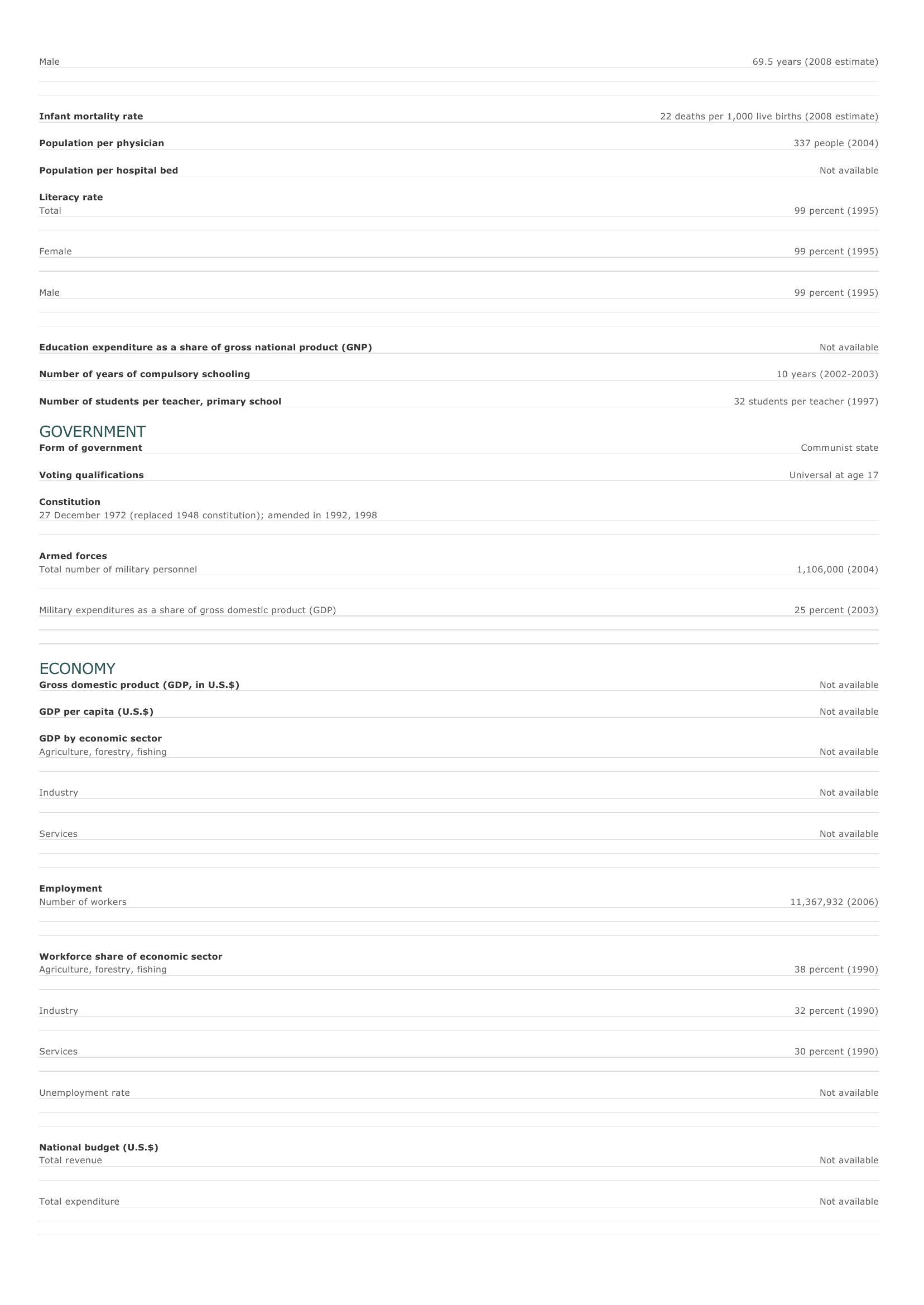North Korea Facts and Figures. BASIC FACTS Official name Capital Area Democratic People's Republic of Korea P'y? ngyang 120,538 sq km 46,540 sq mi PEOPLE Population 23,479,089 (2008 estimate) Population growth Population growth rate 0.73 percent (2008 estimate) Projected population in 2025 25,755,007 (2025 estimate) Projected population in 2050 26,363,688 (2050 estimate) Population density 195 persons per sq km (2008 estimate) 505 persons per sq mi (2008 estimate) Urban/rural distribution Share urban 62 percent (2005 estimate) Share rural 38 percent (2005 estimate) Largest cities, with population P'y? ngyang 3,228,000 (2003 estimate) Namp'o 715,000 (2007 estimate) Ch' ?ngjin 754,100 (2007 estimate) K aes? ng 334,433 (1993) S in ?iju 326,011 (1993) Ethnic groups Languages Ethnically homogeneous Korean (official) Religious affiliations Atheist 16 percent Indigenous beliefs 12 percent Buddhist 2 percent Christian 2 percent Nonreligious 56 percent Other, including Ch'ondogyo (syncretic Korean religion) 12 percent HEALTH AND EDUCATION Life expectancy Total 72.2 years (2008 estimate) Female 75.1 years (2008 estimate) Male Infant mortality rate Population per physician Population per hospital bed 69.5 years (2008 estimate) 22 deaths per 1,000 live births (2008 estimate) 337 people (2004) Not available Literacy rate Total 99 percent (1995) Female 99 percent (1995) Male 99 percent (1995) Education expenditure as a share of gross national product (GNP) Number of years of compulsory schooling Number of students per teacher, primary school Not available 10 years (2002-2003) 32 students per teacher (1997) GOVERNMENT Form of government Communist state Voting qualifications Universal at age 17 Constitution 27 December 1972 (replaced 1948 constitution); amended in 1992, 1998 Armed forces Total number of military personnel 1,106,000 (2004) Military expenditures as a share of gross domestic product (GDP) 25 percent (2003) ECONOMY Gross domestic product (GDP, in U.S.$) Not available GDP per capita (U.S.$) Not available GDP by economic sector Agriculture, forestry, fishing Not available I ndustry Not available Services Not available Employment Number of workers 11,367,932 (2006) Workforce share of economic sector Agriculture, forestry, fishing 38 percent (1990) I ndustry 32 percent (1990) Services 30 percent (1990) Unemployment rate Not available National budget (U.S.$) Total revenue Not available Total expenditure Not available Monetary unit 1 North Korean won (Wn), consisting of 100 chon Major trade partners for exports Japan, China, Costa Rica, Brazil, and Bangladesh Major trade partners for imports Japan, China, Brazil, India, and Singapore ENERGY, COMMUNICATIONS, AND TRANSPORTATION Electricity production Electricity from thermal sources 43.80 percent (2003 estimate) Electricity from hydroelectric sources 56.20 percent (2003 estimate) Electricity from nuclear sources 0 percent (2003 estimate) Electricity from geothermal, solar, and wind sources 0 percent (2003 estimate) Number of radios per 1,000 people 146 (1997) Number of telephones per 1,000 people 44 (2003) Number of televisions per 1,000 people 60 (2000 estimate) Number of Internet hosts per 10,000 people Daily newspaper circulation per 1,000 people Number of motor vehicles per 1,000 people Paved road as a share of total roads Not available 200 (1996) Not available 6 percent (1999) SOURCES Basic Facts and People sections Area data are from the statistical bureaus of individual countries. Population, population growth rate, and population projections are from the United States Census Bureau, International Programs Center, International Data Base (IDB) (www.census.gov). Urban and rural population data are from the Food and Agriculture Organization (FAO) of the United Nations (UN), FAOSTAT database (www.fao.org). Largest cities population data and political divisions data are from the statistical bureaus of individual countries. Ethnic divisions and religion data are largely from the latest Central Intelligence Agency (CIA) World Factbook and from various country censuses and reports. Language data are largely from the Ethnologue, Languages of the World, Summer Institute of Linguistics International (www.sil.org). Health and Education section Life expectancy and infant mortality data are from the United States Census Bureau, International Programs Center, International database (IDB) (www.census.gov). Population per physician and population per hospital bed data are from the World Health Organization (WHO) (www.who.int). Education data are from the United Nations Educational, Scientific and Cultural Organization (UNESCO) database (www.unesco.org). Government section Government, independence, legislature, constitution, highest court, and voting qualifications data are largely from various government Web sites, the latest Europa World Yearbook, and the latest Central Intelligence Agency (CIA) World Factbook. The armed forces data is from Military Balance. Economy section Gross domestic product (GDP), GDP per capita, GDP by economic sectors, employment, and national budget data are from the World Bank database (www.worldbank.org). Monetary unit, agriculture, mining, manufacturing, exports, imports, and major trade partner information is from the statistical bureaus of individual countries, latest Europa World Yearbook, and various United Nations and International Monetary Fund (IMF) publications. Energy, Communication, and Transportation section Electricity information is from the Energy Information Administration (EIA) database (www.eia.doe.gov). Radio, telephone, television, and newspaper information is from the United Nations Educational, Scientific and Cultural Organization (UNESCO) database (www.unesco.org). Internet hosts, motor vehicles, and road data are from the World Bank database (www.worldbank.org). Note Figures may not total 100 percent due to rounding. Microsoft ® Encarta ® 2009. © 1993-2008 Microsoft Corporation. All rights reserved.













